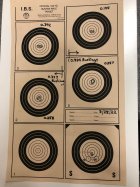Bill - I think what he's asking is akin to had you fired 4 x 5-shot groups using solely the .324" bushing load, would the target have looked about the same? Or would all 4 groups have looked just like the single .324" bushing group on the target you posted (i.e. all very tight)? In other words, might some of the size variance in the groups shown simply be due to shooter error (or some other variable) besides neck tension?
This is a difficult question to answer. It is not uncommon to find "discussions" at shooting forums about 3-shot groups versus 5-shot; or questions regarding just how many shots are necessary for a group to have some statistical relevance. Personally, I've been doing seating depth testing using 3-shot groups for a long time now. In my hands, 3-shot groups for that purpose seem to be just as telling/revealing as 5-shot groups, because I test exactly as I shoot in matches, from a bipod, and it's not uncommon for me to jerk the trigger on occasion when doing 5+ shot groups, thereby wrecking the group I was shooting. So using larger group size is often more about testing my consistency, rather than the load development itself.
I would imagine with the 30BR off a solid front rest that you are able to shoot groups like the .324" bushing very consistently, so if you had fired 4 x 5-shot groups solely using the .324" bushing load, there would have been 4 very tight round groups on the target, rather than one tight group and three that had opened up a bit as seen with the other three diameter bushings.
Thanks for posting these results! I have always tried to target somewhere in the neighborhood of 1.5 to 2 thousandths neck tension with my F-TR .308 Win and .223 Rem loads. After seeing your results, I'm thinking a little more experimentation with neck tension might be in order.












